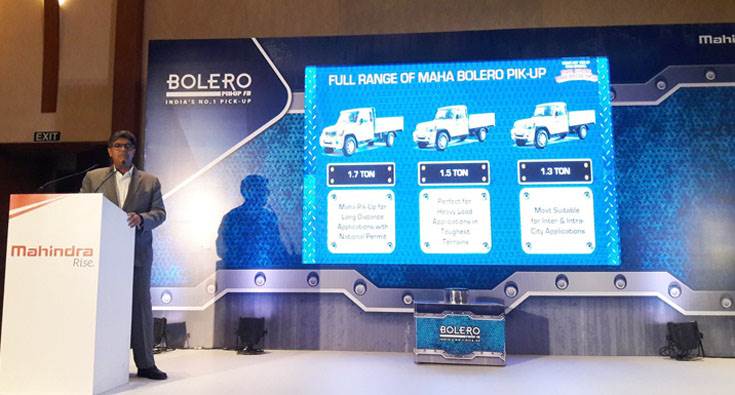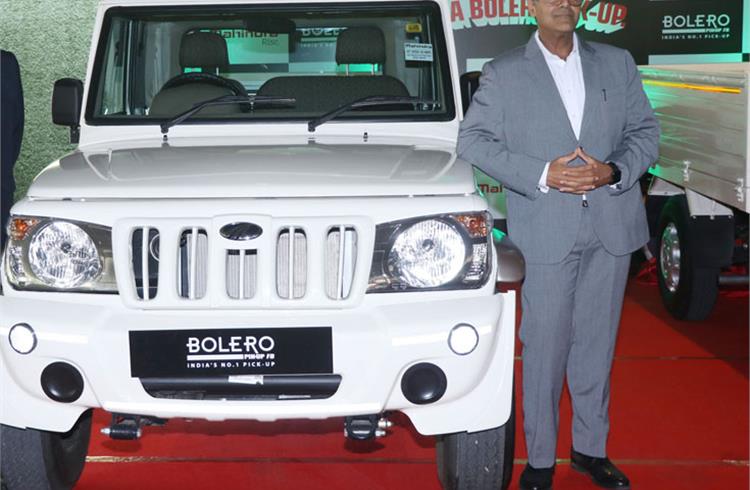Veejay Ram Nakra: .’The new Bolero 1.7-tonne pick-up is for larger loads and longer distances.’
Veejay Ram Nakra, Chief of Sales & Marketing, Auto Division, Mahindra & Mahindra, on the just-launched Bolero 1.7-tonne pick-up variant, expansive business applications with the Bolero range and lots more.
Autocar Professional caught up with Veejay Ram Nakra, Chief of Sales & Marketing, Auto Division, Mahindra & Mahindra, on the sidelines of the national launch of the Bolero 1.7 tonne pick-up variant in Pune today. Pushing the payload capacity further, now to 1700kg, M&M aims to capitalise on the growing business applications with the start of the festive season this year. For M&M, which has sold more than 1,000,000 units of its pick-up range so far, Maharashtra, Madhya Pradesh, Uttar Pradesh and Rajasthan are top markets. Excerpts from the interaction:
How is Mahindra & Mahindra planning to further build upon its existing pick-up vehicle portfolio? Who are the target customers for Mahindra’s Bolero pick-up range?
As you know, M&M is the leader in the pick-up space in India. For 20 years we have been the leaders in this category of vehicles as we have constantly innovated and launched new products in the market. We have launched today a new version of the Bolero pick-up – the Maha-Bolero Pick-up. For the first time in India, a pick-up brand is now going to be available with capacity to carry 1700kg, which is the biggest of its kind in its segment.
Along with that we are also upgrading the existing (Bolero) pick-ups that we have in our portfolio. These are the 1.3-tonne and the 1.5-tonne variants. Thus, from today, we will have the entire large pick-up range available (with new features) from 1.3 tonnes to 1.7 tonnes.
As far as the target customers are concerned, we have two large segments that we cater to. We’ve got the market load operator, which is the stands, and the second is the captive segment. So this product will fit into both the categories. In fact, it (1.7 tonne model) will fit a lot more in the captive segment because this product will need a national permit, because it is a 1.7 tonne pick-up truck, and hence we find the application of this will be more for inter-city rather than intra-city jobs.

What is the fundamental reason behind revamping the pick-up portfolio, and why is the new variant positioned under the Bolero brand?
Bolero is a well-known brand. We have revamped the portfolio because we are increasingly seeing that there are many products now available in the 0.7 tonne to 1 tonne range and the large pick-ups need their distinct space.
With the launch of the Maha Bolero Pick-up, we will have a full range between the Jeeto, Supro and Bolero starting from 0.5 tonne, 0.7 tonne, 0.9 tonne, 1.3 tonne, 1.5 tonne to now 1.7 tonne. It gives us an entire spread of portfolio with reasonable gaps between payload capacities based on user applications to have full range commercial vehicles available.
Did you conduct any customer survey to know whether there is a need for a 1.7-tonne payload capacity pick-up in the local market?
Customers are always at the centre of our decision-making. Like we said, a lot of people who wanted to ply goods for short-distance inter-city movements wanted a vehicle which could have the ability to carry more load. Up to two tonnes there is no limitation in terms of carrying load, and hence the requirement for the 1.7 tonne payload ability came from the customers.
Prior to the 1.7 tonne pick-up launched today, industry had up to the 1.5 tonne vehicle (Bolero pick-up), again we were the pioneers to launch it in India. Today we are being a pioneer again by launching the 1.7-tonne variant.
What specific customer applications is the 1.7 tonne vehicle built for?
It can accommodate a 9-oot-long cargo box / container. It will have the ability to carry all forms of goods, whether it is volume-based or load-based. So it would be very difficult to categorise specific applications. The vehicle can be used for multiple applications such as dairy and agri products, mineral water and in other areas.
Do you think it can also be used by the logistics service providers to, say, Amazon, Flipkart and similar platforms?
I think, on the contrary, Amazon and Flipkarts deploy smaller vehicles, more in the Jeeto kind of space. I would say that the Jeeto products are very well accepted in that segment. Swacch Bharat and e-commerce is typically looked after by the Jeeto segment small commercial vehicles. Those LCVs are for smaller loads, small distance and quick turnarounds type of requirements. The Bolero 1.7 tonne pick-up is for larger loads and longer distances.
What new updates on the engineering side are given to the existing frame to be able to withstand additional load capacity in the new 1.7-tonne variant?
Obviously, it will require some axle modification and suspension change. We have done all of that in the product. That’s how we have been able to enhance its payload capacity. The powertrain, on the other hand, remains the same. It is a diesel engine (four-cylinder, 2.5-litre, 70bhp at 3200rpm, 200Nm at 1400-2200rpm) with sufficient power and torque to carry the load.
What are the key markets for the Bolero pick-up SCVs?
The heartland of India is a very big market for us. That includes Rajasthan, Uttar Pradesh, Madhya Pradesh, Chattisgarh, Bihar and Maharashtra. These are big markets for us. Needless to say, the south is also a very big market for commercial vehicle application and hence Tamil Nadu and Andhra Pradesh are also significantly large markets for pick-up vehicles.
How do you view the market structure across India for these pick-ups? Which are the top contributors to M&M’s Bolero pick-up sales?
We break our structure into five zones: north (Jammu & Kashmir, Punjab, Haryana, Uttarakhand, Uttar Pradesh and Himachal Pradesh), north-west (Delhi NCR, Rajasthan and Gujarat), east (Bihar, Jharkhand, West Bengal and all of North East markets), south (Telangana, Andhra Pradesh, Tamil Nadu, Kerala and Karnataka) and west (Madhya Pradesh, Chattisgarh and Maharashtra). The top contributors are Maharashtra, Madhya Pradesh, Uttar Pradesh and Rajasthan.
Can you throw some light on the market size of pick-up vehicles in India?Typically the industry is about 20,000- 22,000 vehicles per month in this category. This segment has been growing about 17 percent. We continue to be the market leaders in this category with a share in the range of 62-70 percent.
Apart from soaring fuel prices, how do you evaluate the market sentiment in Q3 FY2019?
I think the festive season is looking buoyant; we can see that the demand is back and customer sentiments are healthy. The first day of Navratri was very good for us, it was better than last year. So we are very hopeful that Q3 will be a very good quarter for us.
RELATED ARTICLES
Setrans Mobility Booster Charging top-up 25% EV range in 15 minutes
Two enterprising tech-savvy entrepreneurs Rana Roshan Singh and Vivek Ummat of Noida, Uttar Pradesh-based start-up Setra...
'Our products are proudly 100% designed and made in India'
Creatara Mobility, a New Delhi based electric two-wheeler startup, claims to have tackled various challenges in making i...
'EVs have been around for a much smaller time than ICE, so best practices are still evolving'
EV OEMs and start-ups are under pressure to reduce production costs and bring them close to ICE counterparts. Vaibhav Ku...





 11 Oct 2018
11 Oct 2018
 50775 Views
50775 Views





 Autocar Pro News Desk
Autocar Pro News Desk




